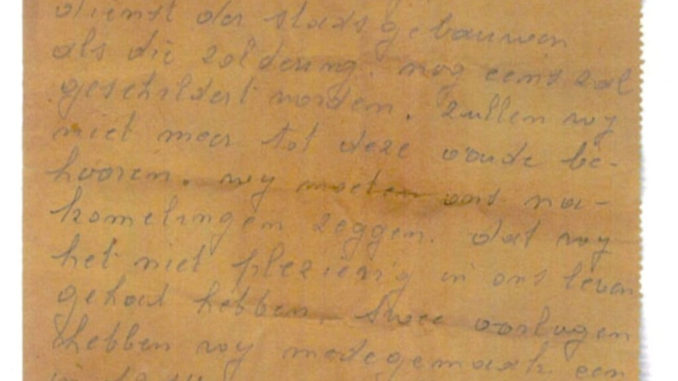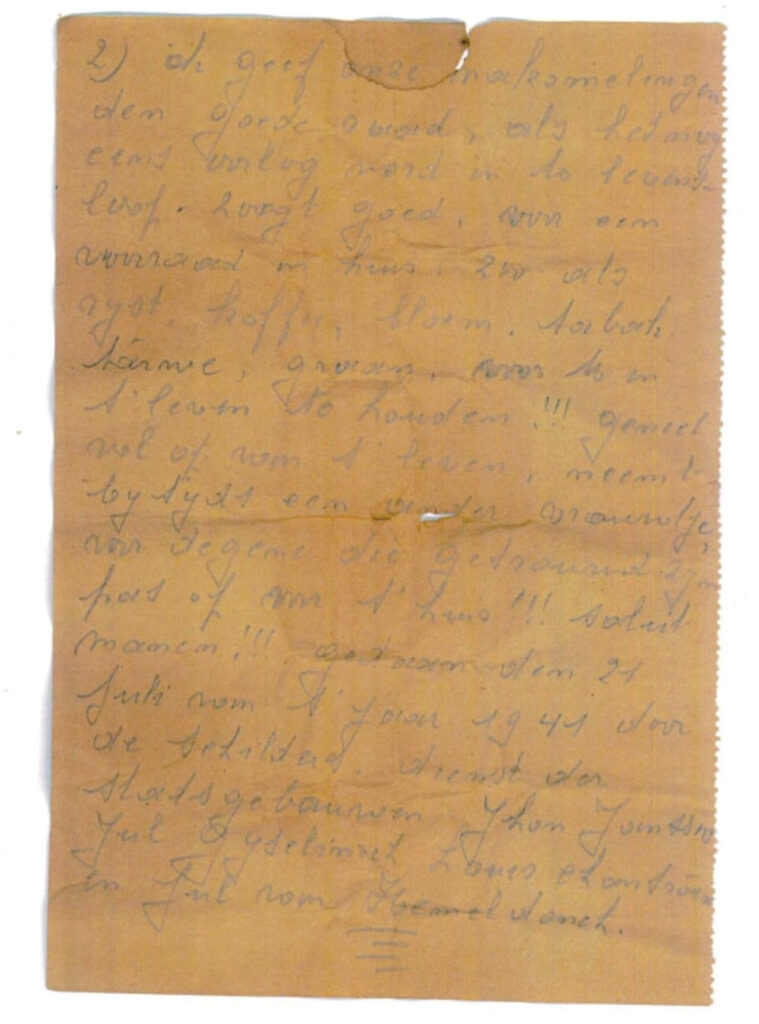
But in a nod to the future, the 1941 note also contained the workers’ recommendations on what staples to stock in case of another war, and also to “enjoy life to the fullest.”
The quartet of craftsmen stuffed a matchbox with the message and hid it in a keystone of the ceiling of the Sint-Jacob Church in Antwerp, Belgium, on July 21, 1941. More than 80 years later, their warning has seen the light of day again.

The church dates back to 1314 and was visited by Mozart when he was 9 years old. In 1940, it was in dire need of restoration. Due to the war, funds were very low, but the church managed to hire three painters and a lighting expert from the city’s building department to carry out the project to celebrate the 300th birthday of famed Flemish painter Pieter Paul Rubens, who is buried there.
On May 28, 1941, these four men began working on the church’s roughly 90-foot-high ceiling: Jules Gijselinck, 44; Jan Juliaan Van Hemeldonck, 40; Jan ‘John’ Janssen, 40; and Louis Chantraine, 28. They stood on wooden scaffolding that could only be moved around using a horse, completing their work two months later.
They had to work through city riots as Belgian patriots clashed with Nazi sympathizers outside the church after the Nazis banned the country’s Nationale Feestdag celebration, which is held annually on July 21.
Toward the end of the job, they used two blank order tickets from the city and wrote about their lives. They then hid it in a matchbox placed in one of the keystones — the ornamental stonework that supports the center of each vault.
The men have all since died and kept their note a secret until it was found in early October during the first renovation work undertaken in 80 years.
The note reads:
“21 July 1941
“In 1941 the ceiling of the church is glued with a rolling scaffold 27 meters high, for the service of city buildings.
“When the ceiling is repainted [again], we will no longer belong to this earth, so we must tell our descendants that we did not enjoy our lives. We have been through two wars, one in 1914 and one in 1941, and we can still count!
“We stand here working hungry, they squeeze us to the last penny for a little food.
“I advise our descendants, if war comes again in the course of their lives, to keep a supply of rice, coffee, flour, tobacco, wheat, [and] grain in the house for you! Enjoy life to the fullest, take in another female in time, for those who are married, look after the house! Salut men!
“Done on the 21st of July 1941 by the painters service of the buildings John Janssen, Jul Gyselinck, Louis Chantraine and Jul van Hemeldonck.”
“The note is so special because it is a silent, but a very sincere echo of four workers who, for the second time, experienced a war that strongly influences their lives,” Antwerp City Archives historian Werner Pottier, who has been researching the men since the note was found, told Zenger News. “From their personal situation, they give good advice to the future reader, not knowing when and by whom their message will be found.
When the note was written, Antwerp had been occupied for more than a year by German forces, and the city’s food supply was dwindling.
“Prices on the black market were skyrocketing. It is often a choice between hunger or paying a lot for little food. It is therefore significant that the four workmen cite both world wars, wars that made their lives ‘unpleasant’,” Pottier wrote.
Indeed, World War I also shaped the men’s lives, Pottier’s research found.
Gijselinck was the eldest of the four workers who helped write the note. He came to Antwerp as a plumber in October 1920, after surviving World War I on the front after enlisting at age 17.
“In 1929, he retrained as a stonemason and immediately received his baptism of fire: since only two stonemasons work in the city and his colleague is already busy,” Pottier wrote. “Gijselinck is given the unsavory task of cleaning and sanding the bluestones in which the dust has penetrated too deeply in urban schools.
“He quickly stopped working and returned to the plumbing 15 months later to join the painter’s team on Jan. 1, 1940.”
World War I had also impacted Chantraine. His father, Alfons, was among the Antwerpen soldiers to have died during the war while Louis was a baby. Alfons has a street named after him in the Wilrijk district.

Janssen was hired as a temporary worker by the city and had been a painter since dropping out of school at age 12. He did not become an Antwerp citizen until August 1942.
Van Hemeldonck was the team’s ceiling expert. He retired 12 years later.
The original matchbox will go to the Museum aan de Stroom as part of a collection of World War II memorabilia that is on display there until September 2021.
In addition, a copy of the note will be put back behind the keystone with an additional letter for the next generation, once the current renovations are completed, church officials say.
(Edited by Matthew B Hall and Carlin Becker)
The post Message in a Matchbox: Warning from 1941 Found in Belgian Church appeared first on Zenger News.
